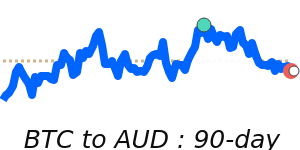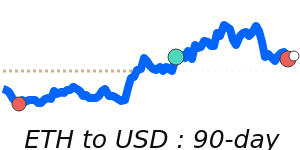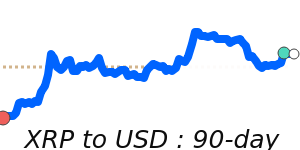Forecasts for BTC to USD
![]()
![]() Recent forecasts suggest a complex outlook for the BTC to USD exchange rate driven by both geopolitical factors and evolving monetary policies. As of December 22, 2025, Bitcoin is trading around $89,700, reflecting a marginal increase of 0.01% from previous sessions. However, this figure represents a significant decline of 13.5% below its three-month average of $100,901, illustrating the cryptocurrency's volatility where fluctuations in value have spanned nearly 48.5% within a range of approximately $84,381 to $125,277.
Recent forecasts suggest a complex outlook for the BTC to USD exchange rate driven by both geopolitical factors and evolving monetary policies. As of December 22, 2025, Bitcoin is trading around $89,700, reflecting a marginal increase of 0.01% from previous sessions. However, this figure represents a significant decline of 13.5% below its three-month average of $100,901, illustrating the cryptocurrency's volatility where fluctuations in value have spanned nearly 48.5% within a range of approximately $84,381 to $125,277.
Analysts have noted that the recent retreat of the US dollar, triggered by a softer Consumer Price Index (CPI) reading and indications of potentially aggressive interest rate cuts by the Federal Reserve in 2026, can provide some support for Bitcoin and other risk assets. The anticipated easing of monetary policy is believed to narrow interest rate differentials, leading to downward pressure on the USD. Consequently, as market expectations shift towards a dovish Federal Reserve strategy, risk assets like Bitcoin could become more attractive to investors.
Supporting this scenario, the Federal Reserve’s pause on its Quantitative Tightening program aims to create a more favorable environment for risk assets, which includes Bitcoin. The broader investment community is closely monitoring upcoming economic data, such as the inflation reading and consumer sentiment indicators, which could offer further insights into USD performance and its impact on cryptocurrency valuations. Should upcoming reports confirm ongoing economic cooling, Bitcoin may find a stronger footing.
Moreover, Bitcoin's recent market updates highlight its susceptibility to macroeconomic developments. Although a Strategic Bitcoin Reserve established by the US aims to bolster its status in the cryptocurrency space, the liquidation events and market sell-offs observed in late 2025 have injected uncertainty into Bitcoin's trajectory.
In the face of mixed signals from US economic data, including relatively strong labor markets coupled with signs of slowing growth, forecasters remain watchful. The current geopolitical environment, paired with recent fiscal concerns related to the US deficit, may lead to further fluctuations in the USD, thereby continuing the volatile landscape for Bitcoin. Should risk-on sentiment prevail in global equity markets, analysts anticipate that this dynamic may limit potential gains for the USD, further enhancing Bitcoin's attractiveness as an alternative asset. Observers will need to stay attuned to Federal Reserve communications and economic indicators to anticipate future movements in both the USD and BTC.



